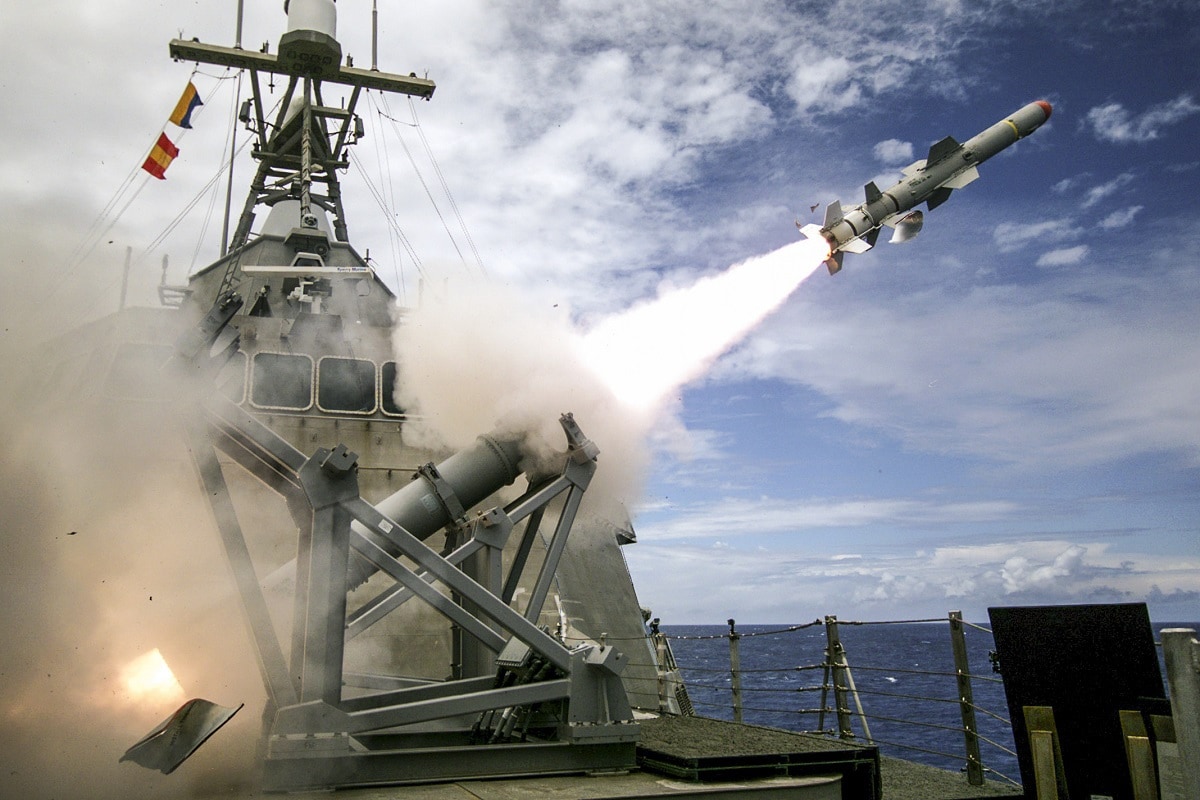What goes around comes around. It seems like it was just yesterday that Yours Truly wrote an article for 19FortyFive detailing the history of the Harpoon anti-ship missile. Therein, I gave the weapon the tongue-in-cheek sobriquet “The Harmful Hoary Harpoon,” in honor of the great WWE pro wrestler Triple H (Hunter Hearst Helmsley). I described some historical successes of the Harpoon in actual combat—such as Operation Praying Mantis in 1988—as well as discussed present and future upgrades to the weapons system.
Well, now that the Ukrainians have successfully deployed the weapon against Russian aggression in the Black Sea, it’s clear to see that this “Triple H” (so to speak) is not a mere blast from the past. Let’s take a closer look at these latest developments.
Prelude
Back in May, U.S. SECDEF Lloyd Austin had announced that NATO ally Denmark had pledged a quad truck-mounted launcher for Harpoon missiles as a donation to Ukraine. Copenhagen made this pledge during a virtual meeting of the so-called Ukraine Defense Contact Group. At the time, Secretary Austin stated, “I’m especially grateful to Denmark, which announced today that it will provide a Harpoon launcher and missiles to help Ukraine defend its coast.”
A major motivational factor behind the decision to provide the Harpoons to Ukraine was the hope of breaking Russia’s blockade of Odesa, Ukraine’s largest port on the Black Sea. This blockade has now dragged on for well over 120 days.
As stated at the time by Joint Chiefs of Staff Chairman Gen. Mark Milley, “I think it’s quite important to the economy of Ukraine, and many countries in the world depend on Ukrainian grain. As for what we’re doing about it, right now we don’t have any naval assets on the Black Sea, we don’t intend to. Right now it’s a bit of a stalemate between the Ukrainians wanting to make sure there isn’t an amphibious landing around Odessa. Right now it’s a no-go for commercial shipping.”
Besides the physically destructive capabilities of the missile, there’s also a distinctive monetary advantage to the Harpoon, that being its cost-effectiveness. The weapon is comparatively inexpensive to produce at around 1.65 million USD, equivalent to 48.5 million Ukrainian Hryvnia. As I wrote in the May article for 19FortyFive, “plenty of the proverbial bang for the buck (or hellfire for the Hryvnia if you prefer).”
The Payload Pays Off
Less than a month later, that “hellfire for the Hryvnia” deal is already starting to pay dividends for the embattled Ukrainian Armed Forces.
On Friday 17 June 2022 (yesterday morning as these words are written), its forces claimed that they hit a Russian naval tugboat with two Harpoons in the Black Sea. If indeed true, this would be the first time that they have struck a Russian vessel with Western-supplied anti-ship weapons; the much-ballyhooed sinking of the Black Sea flagship Moskva had been accomplished with the homegrown Neptune missile. As stated in a press release by Kyiv’s Armed Forces Strategic Communications Directorate:
“During the full-scale war in the Black Sea, (anti-ship missiles) were used twice, first the (Ukrainian-made) Neptune, and today, June 17, the Harpoon. Both uses were successful. At the same time, the air defense of Russian ships proved to be entirely ineffective.”
Not surprisingly, the Russian government and its media mouthpieces have been mum on the alleged incident thus far.
The victimized Russian tugboat in question was ID’d as the Vasiliy Bekh by the Odesa region’s governor. This tug had actually been initially designed as a rescue vessel, but in this instance been transporting soldiers, weapons, and ammunition to the Russian-occupied Zmiinyi (“Snake”) Island. Yes, ladies and gents, the same Snake Island of the immortalized “Russian warship, go f*** yourself” incident. By the way, the name of the courageous Ukrainian soldier who made that famous broadcast is Roman Hrybov, and back on 29 March he was awarded a medal by the local authorities in his home city of Cherkasy.
The Bekh was a relatively new addition to the Russian Black Sea Fleet, commissioned into the Russian Black Sea Fleet in March 2017. It had been laid down at the Astrakhan Shipyard, launched in August 2016, and in the fall of the same year it was towed to Russian-occupied Sevastopol. Previously designated SB-739, the Rescuer Vasily Bekh received its new official name in April 2021 in honor of the chief engineer of the search and rescue department of the Black Sea Fleet. The vessel has a displacement of 1,670 tons, a length of 57 meters (187 feet), and a max speed of 14 knots.
The “entirely ineffective” air defense system of the tugboat that the Ukrainian press release was alluding to was most likely the TOR anti-air missile system AKA the SA-15 “Gauntlet.” It is a 26-year old weapons system with a 15 kilogram (33 pound) and a range of 12-16 kilometers (7.45-9.94 miles).
Initial reports indicate that up to 70% of the 26-person crew of the Bekh were killed, the fate of the others is unknown.
Christian D. Orr is a former Air Force officer, Federal law enforcement officer, and private military contractor (with assignments worked in Iraq, the United Arab Emirates, Kosovo, Japan, Germany, and the Pentagon). Chris holds a B.A. in International Relations from the University of Southern California (USC) and an M.A. in Intelligence Studies (concentration in Terrorism Studies) from American Military University (AMU). He has also been published in The Daily Torch and The Journal of Intelligence and Cyber Security. Last but not least, he is a Companion of the Order of the Naval Order of the United States (NOUS).

